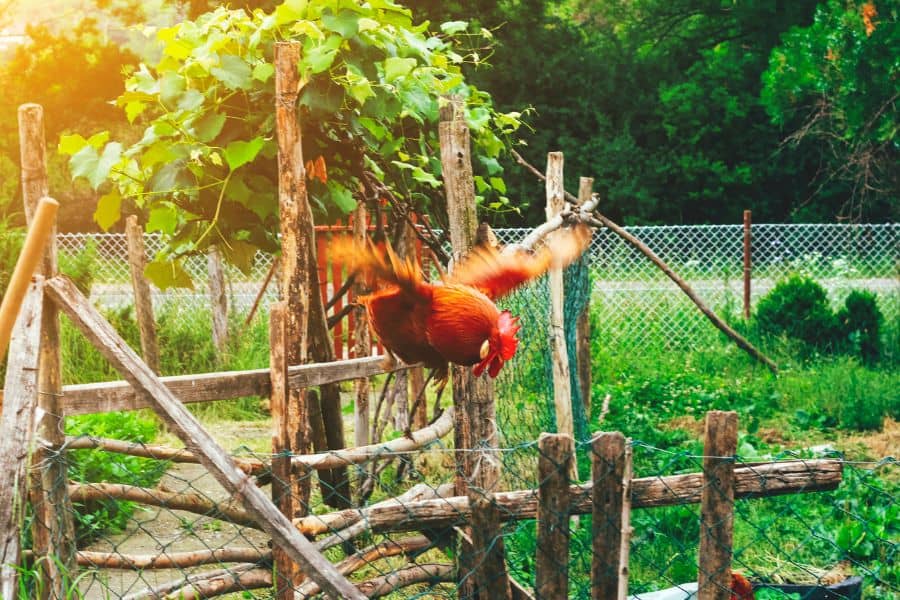Let’s be honest – Roosters are true maestros of the avian kingdom. Leave alone their melodious cock-a-doodle-doos at the crack of dawn; cockerels are intelligent feathered heroes with excellent leadership skills and so much more.
But how about their aerial capabilities – can roosters fly?

Well, that’s what we’re about to unearth in this blog post. Herein, we’ll examine the enigma surrounding these majestic creatures and whether or not they are true stars in the air, just as on the ground.
Can Roosters Fly?
The human-chicken companionship has come a long way. In fact, if this article by the University of Wisconsin is anything to go by, the domestication of chickens began 7,000 to 10,000 years ago. That’s a pretty decent period of friendship.
But even with all this time of interaction, some topics about our feathered friends remain a subject of hot debate – and whether or not roosters can fly is a case in point.
On one side of the debate, people say that roosters, and chickens generally, don’t fly. At the opposite side, another category of people swear by how they’ve even witnessed their feathered friends express their aerial prowess.
So, who’s right – Do roosters actually fly?
Yes, roosters fly, but the answer really isn’t that simple. These birds can “fly” because they can maneuver in the air, flapping their wings. But they just aren’t any good at it.
In fact, if we were to stick to the true sense of the word “fly”, then we’d say roosters don’t fly… yes, that’s how bad their “flying” is!
Usually, roosters will make short bursts of flight when it’s really the only option they’re left with, but they won’t produce a sustained aerial movement like strong fliers.
And by the way, they know they aren’t good at it and will often avoid it, even when it would have been a much better option.
So generally, while our male feathered friends can fly over very short stretches, they aren’t so adept at it that it’s still considered correct to say they don’t actually fly.
But to appreciate the little effort they put into it, in this article, we’ll stick to the fact that they can fly albeit their flying skills are below average.
3 Main Reasons Roosters Don’t Make Adept Fliers
From the looks and the fact that they’re under the category of birds, we expect roosters to be very good in the air. After all, flying is the common way birds maneuver their surroundings.
But that’s not exactly the case with cockerels.
These majestic beings live as grounded creatures and often prefer to run than walk, stirring up our curiosity. After all, doesn’t flying seem more fun than walking?
Well, to satisfy your curiosity and provide answers to some lingering questions about roosters’ flying capabilities, let’s examine common reasons cockerels don’t do well in flying.
1. Improper Wingload
For birds to fly properly, they need an appropriate wingload. By that, we mean their body mass to wing area ratio must be within a particular range.
When the wingload is off, birds are unable to fly, or at least not good enough at it.
Wingload is usually expressed in kilograms per square meter (kg/m2) or ounces per square foot (oz./ft2). According to experts, birds need a proportionate wingload of 20 kg/m2 to fly efficiently and perfectly.
It’s not cast in stone, though, but this ratio must be less than 25 kg/m2 if the bird has to possess any flying capabilities. In other words, a bird will be unable or have difficulty to fly if its wingload translates to a bigger ratio than 25 kg/m2.
And that’s the case with roosters!
Although they have wings and usually a good mass of feathers to facilitate their movement in the air, roosters have a big wingload. That’s to say; they are just way too heavy for their wings, which is one of the reasons they don’t stay airborne.
2. Selective Breeding Over the Years
Selective breeding helps us develop organisms with more desirable traits and less or none of the undesirable ones. The practice has its set of positives, but we still can’t ignore that it also has a negative side.
For one, over the years, selective breeding in roosters has inadvertently weakened the birds’ capability to fly. That’s because it often focuses on traits that benefit humans and not necessarily the bird.
Let’s take roosters bred for meat purposes as an example. The breeder’s main interest is to develop beefy birds that take less time to reach maximum size.
Of course, that has nothing to do with the wings, so they’re likely to ignore modifying them proportionately, making the wingload even less favorable to support flight.
3. Adaptation to Ground Living
Lastly, roosters’ domesticated life is the other reason they aren’t usually flighty. It may not have played a major role in turning them into the “nearly flightless” creatures they’re today, but it has had an impact whatsoever small.
Unlike in the wild, domesticated life usually doesn’t necessitate flying. So, if they’re more likely to do it less often, they’re less likely to become good at it. After all, executing anything perfectly usually requires some practice, which roosters seldom do!
The Rooster Breed Really Matters
While roosters are generally not good at flying, some breeds perform better than others. Some of the chicken breeds considered better include:
- Leghorn
- Araucana
- Anconas
- Andalusian
- Minorca
- Long-tailed Phoenix chicken
The list doesn’t end there. But the most important thing to note is that flying capability differs with the breed and sometimes the individual roosters, so don’t be surprised if you have two roosters of the same breed exhibiting variant flying capabilities.
If you have a bantam breed, you should be more careful, as these breeds have a comparatively smaller body weight to wing size ratio.
Reasons Your Rooster Might “Fly” Away
Although they’re very less likely to do it, we still can’t ignore that roosters have wings and can occasionally make short bursts of flight.
Here are some main reasons that can leave your rooster with no option other than flying away.
Lack of Basic Needs
Your flock needs basic needs like food and water to survive as much as you do. If you don’t provide enough of either, it can push them to fly and seek them elsewhere, especially if they don’t have enough area to forage.
Predators
Our feathered friends come near the bottom of the food chain. That means they sometimes have to do everything necessary to evade the imminent danger of predators, even if it means flying.
In fact, if your flock has an adequate supply of basic needs, predation is the next likely reason your birds will opt to fly.
Common chicken predators include:
If the escape has anything to do with danger, it will usually be accompanied by the chickens making a clucking sound, so always check out for any threat and adopt the necessary action.
Other Reasons
The lack of basic needs and predation aren’t the only reasons roosters can fly. Factors like circumstance, breed, and the bird’s traits can also play a part.
Some roosters can even do it because they see it as fun. So basically, while our male feathered friends aren’t good at flying, their flight capabilities and how often they’re likely to do it depend on several factors.
Keeping Your Rooster from Escaping
If you’ve noticed that your rooster is the kind that’s more inclined to fly, you might want to know some of the ways you can contain them.
Here are effective ways to do that:
Install Reliable Fencing
Installing proper fencing is one way to keep your feathered companions from flying outside your yard.
For a chicken-proof fence, the general rule dictates a height of at least 6 inches. You can work with about 9 inches if you have flighty chicken breeds.
That way, you’ll keep your chickens from flying over it.
Meet their Basic Needs
If you suspect inadequate basic needs could be why your roosters tend to fly away, offer them what they’re missing. Frequently replenish their feeders and water bowls so they won’t have to look for either elsewhere.
Use a Chicken Run
Some rooster breeds are free rangers and will want to explore everything within and beyond their surroundings. If you have such a breed, a chicken run should come to your rescue.
A chicken run provides chickens with adequate space to forage while keeping them put at the same time. Plus, it will protect them from predator attacks. But of course, it may not be the best option for those who don’t have much space.
Clipping the Wings
Even though chicken wings have evolved with time, they are still among the chicken’s greatest enablers of flight. So, if you’ve been struggling to keep your birds within your space, trimming their wings should solve the problem.
Go for the primary flight feathers – the long feathers usually at the front of the wing. You only need to target one wing, as it will throw off the balance whenever the chicken attempts to initiate a flight.
But then, feather-clipping may not be the best idea, as it may make the bird an easy target for predators. Plus, you’ll still need to retrim it occasionally since primary feathers grow back.
FAQs
How Long Can a Rooster Fly?
It depends on the breed. The best fliers will span a distance of up to 50 feet, but they’ll fly close to the ground – about 10 feet high at their very highest. The longest recorded chicken flight was 301.5 feet and lasted 13 seconds.
How High Can Roosters Jump?
Chickens typically jump up to 4 to 6 feet, depending on the breed. However, if you have a bantam rooster, don’t be surprised when you see them jumping up to 8 feet high to roost.
Can Roosters Fly Higher than Hens?
Not exactly. Roosters from flighty breeds will fly higher than hens belonging to breeds with less favorable flight traits. But if they all come from the same breed, the hen is likely to fly higher than the rooster because the former weighs much less.
Conclusion
Although roosters have multifaceted abilities, they aren’t good at flying and often avoid it. Their inability to fly well has more to do with their anatomy than anything else. The flight capabilities may also differ depending on the breed and the individual bird.
It’s important to ensure you incorporate the right measures to prevent them from entering your neighbor’s backyard. With proper measures, you can keep your flock happy, healthy, and well-contained.
